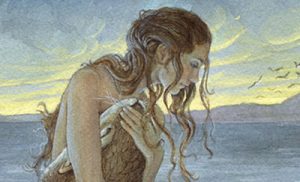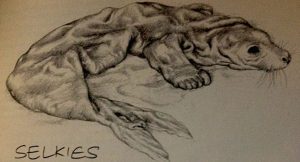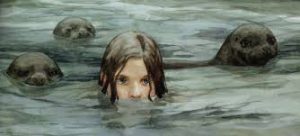As soon as the seal was clear of the water, it reared up and its skin slipped down to the sand. What had been a seal was a white-skinned boy
George Mackay Brown ‘Pictures in the Cave’
In response to the lively interest in my post on selkies and Kaja’s on the pain of transformation for werewolves I thought I would post a further extract on selkie lore describing their magical skins:
In the surviving folklore, there is no agreement as to how often the selkie-folk were able to carry out the transformation. Some tales say it was once a year, usually Midsummer’s Eve, while others state it could be “every ninth night” or “every seventh stream”.
Regardless of how often they were able to transform, the folklore tells us that once in human form, the selkie-folk would dance on lonely stretches of moonlit shore, or bask in the sun on outlying skerries.
A common element in all the selkie-folk tales, and perhaps the most important, is the fact that in order to shapeshift they had to cast off their sealskins. Within these magical skins lay the power to return to seal form, and therefore the sea.
If this sealskin was lost, or stolen, the creature was doomed to remain in human form until it could be recovered. Because of this, if disturbed while on shore, the selkie-folk would hastily snatch up their skins before rushing back to the safety of the sea.
See Orkneyjar.com for more selkie folklore!
Bill is currently reading a very promising YA paranormal romance with selkies–and a witch too (praised by Marcus Sedgwick). It’s Margo Lanagan’s The Brides of Rollrock Island and OGOM contributor Victoria Amador has made us aware of this selkie film, ‘The Secret of Roan Inish’ and there’s even a children’s selkie novel, Mollie Hunter’s A Stranger came Ashore–which looks good and has been well-reviewed.
Katherine Briggs (usually my folklore bible) is a bit short on selkies but she does have an entry on the Orkney Isles where seal maidens are among the commonest of fairy brides and ‘sometimes as in the Orcadian tale of the Great Silkie of Sule Skerry, a mortal woman is wedded to a seal husband’ (Katherine Briggs, The Fairies in Tradition and Literature, p. 52).
Keep sending us your selkie books!




This is beautiful. And definitely inspiring me to write up my selkie short story.
I thought the contrast between the painful transformation of the werewolf and selkies becoming human was quite interesting. Midsummer connects them more to fairy lore than to scary monsters. They seem equally happy as humans dancing on the shore and as seals in the water but of course their human life is only temporary or transitory….echoes of the little mermaid here. She is punished for not returning to the sea when her time on land is seen to be at its end and tries to prolong the experience of having feet instead of a fish tail.
Oh, do write it, Kaja! I feel a touch of selkie possession myself after finishing the lovely novel.
Katherine Briggs does have more to say on silkies (and their relatives, Seal Maidens, the Roane, and the Gwragedd Annwn in her Dictionary of Fairies (Harmondsworth: Penguin, 1976). They are among the gentlest of the fairie people.
Pingback: The Selkie – Born Without Skin | Secret of Cerridwen